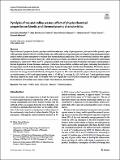Por favor, use este identificador para citar o enlazar a este item:
http://hdl.handle.net/10261/289812COMPARTIR / EXPORTAR:
 SHARE SHARE
 CORE
BASE CORE
BASE
|
|
| Visualizar otros formatos: MARC | Dublin Core | RDF | ORE | MODS | METS | DIDL | DATACITE | |

| Campo DC | Valor | Lengua/Idioma |
|---|---|---|
| dc.contributor.author | Ben Abdallah, Asma | es_ES |
| dc.contributor.author | Ben Hassen Trabelsi, Aïda | es_ES |
| dc.contributor.author | Navarro López, María Victoria | es_ES |
| dc.contributor.author | Veses Roda, Alberto | es_ES |
| dc.contributor.author | García Martínez, Tomás | es_ES |
| dc.contributor.author | Mihoubi, Daoued | es_ES |
| dc.date.accessioned | 2023-02-17T07:48:44Z | - |
| dc.date.available | 2023-02-17T07:48:44Z | - |
| dc.date.issued | 2023-02-10 | - |
| dc.identifier.citation | Journal of Thermal Analysis and Calorimetry 148: 2501-2515 (2023) | es_ES |
| dc.identifier.issn | 1388-6150 | - |
| dc.identifier.uri | http://hdl.handle.net/10261/289812 | - |
| dc.description | 8 figures.-- Supplementary information available. | es_ES |
| dc.description.abstract | Physicochemical properties, kinetic pyrolysis and thermodynamic study of spent green tea, pure spent coffee grounds, spent coffee grounds blended with 50% torrefied barley and coffee husk were experimentally investigated using thermogravimetric analysis under an inert atmosphere to evaluate their thermochemical application. Five isoconversional methods were applied to determine effective activation energy (Ea) of the pyrolysis processes. All methods showed good agreement by determining fluctuating Ea values (150–500 kJ mol−1). Complex Ea profiles with conversion were divided into four stages corresponding to thermal degradation of main biomass constituents (extractives, hemicellulose, cellulose and lignin), indicating that extractives decomposition was the least demanding reaction while lignin decomposition was the most demanding. The kinetic process was verified by reconstruction according to the Friedman parameters. The thermodynamic parameters were evaluated to determine the energy demand and efficiency throughout the process. The values obtained for physicochemical properties such as volatile matter (> 68%) and higher heating value (> 17 MJ kg−1), average Ea (223–319 kJ mol−1) and significant energy efficiency implied that these types of biomass waste have significant reactivity and consequently the highest potential for the production of bioenergy and a range of high-value chemicals and materials. | es_ES |
| dc.description.sponsorship | This work was supported and funded by the Ministry of Higher Education and Scientific Research (MESRST) in Tunisia through the Project “Thermochemical and biochemical conversion of solid waste” under a Contract between the MESRST and the Research and Technology Centre of Energy (Program contract 2019-2022). The financial support for this work also was given by the Spanish Ministry of Science and Innovation, the State Research Agency and the European Funds for Regional Development (No. RTI2018-095575-B-I00, MCI/AEI/FEDER, UE), as well as the Regional Government of Aragon (DGA) under the research groups support programme. Open Access funding provided thanks to the CRUE-CSIC agreement with Springer Nature. | es_ES |
| dc.language.iso | eng | es_ES |
| dc.publisher | Springer Nature | es_ES |
| dc.relation | info:eu-repo/grantAgreement/AEI/Plan Estatal de Investigación Científica y Técnica y de Innovación 2017-2020/RTI2018-095575-B-I00/ES/PROCESOS QUIMICOS AVANZADOS PARA LA CONVERSION DE RESIDUOS EN GAS NATURAL SINTETICO/ | es_ES |
| dc.relation.isversionof | Publisher's version | es_ES |
| dc.rights | openAccess | es_ES |
| dc.subject | Tea waste | es_ES |
| dc.subject | Coffee waste | es_ES |
| dc.subject | Pyrolysis | es_ES |
| dc.subject | Kinetics | es_ES |
| dc.subject | Thermodynamics | es_ES |
| dc.title | Pyrolysis of tea and coffee wastes: effect of physicochemical properties on kinetic and thermodynamic characteristics | es_ES |
| dc.type | artículo | es_ES |
| dc.identifier.doi | 10.1007/s10973-022-11878-4 | - |
| dc.description.peerreviewed | Peer reviewed | es_ES |
| dc.relation.publisherversion | http://dx.doi.org/10.1007/s10973-022-11878-4 | es_ES |
| dc.identifier.e-issn | 1588-2926 | - |
| dc.rights.license | https://creativecommons.org/licenses/by/4.0/ | es_ES |
| dc.contributor.funder | Ministère de l’Enseignement Supérieur et de la Recherche Scientifique (Tunisie) | es_ES |
| dc.contributor.funder | Ministerio de Ciencia e Innovación (España) | es_ES |
| dc.contributor.funder | Agencia Estatal de Investigación (España) | es_ES |
| dc.contributor.funder | European Commission | es_ES |
| dc.contributor.funder | Gobierno de Aragón | es_ES |
| dc.relation.csic | Sí | es_ES |
| oprm.item.hasRevision | no ko 0 false | * |
| dc.identifier.funder | http://dx.doi.org/10.13039/501100000780 | es_ES |
| dc.identifier.funder | http://dx.doi.org/10.13039/501100004837 | es_ES |
| dc.identifier.funder | http://dx.doi.org/10.13039/501100011033 | es_ES |
| dc.identifier.funder | http://dx.doi.org/10.13039/501100010067 | es_ES |
| dc.contributor.orcid | Ben Hassen Trabelsi, Aïda [0000-0002-8473-7119] | es_ES |
| dc.contributor.orcid | Navarro López, María Victoria [0000-0002-4992-9019] | es_ES |
| dc.contributor.orcid | Veses Roda, Alberto [0000-0002-7589-2643] | es_ES |
| dc.contributor.orcid | García Martínez, Tomás [0000-0003-4255-5998] | es_ES |
| dc.contributor.orcid | Mihoubi, Daoued [0000-0001-6652-9693] | es_ES |
| dc.subject.uri | http://metadata.un.org/sdg/7 | es_ES |
| dc.type.coar | http://purl.org/coar/resource_type/c_6501 | es_ES |
| dc.subject.sdg | Ensure access to affordable, reliable, sustainable and modern energy for all | es_ES |
| item.openairetype | artículo | - |
| item.cerifentitytype | Publications | - |
| item.grantfulltext | open | - |
| item.fulltext | With Fulltext | - |
| item.openairecristype | http://purl.org/coar/resource_type/c_18cf | - |
| item.languageiso639-1 | en | - |
| Aparece en las colecciones: | (ICB) Artículos | |
Ficheros en este ítem:
| Fichero | Descripción | Tamaño | Formato | |
|---|---|---|---|---|
| s10973-022-11878-4.pdf | Artículo principal | 1,72 MB | Adobe PDF |  Visualizar/Abrir |
| 10973_2022_11878_MOESM1_ESM.pdf | Información suplementaria | 1,02 MB | Adobe PDF |  Visualizar/Abrir |
CORE Recommender
SCOPUSTM
Citations
10
checked on 06-may-2024
WEB OF SCIENCETM
Citations
6
checked on 22-feb-2024
Page view(s)
49
checked on 18-may-2024
Download(s)
33
checked on 18-may-2024
Google ScholarTM
Check
Altmetric
Altmetric
Este item está licenciado bajo una Licencia Creative Commons



